| Area | Lower Klamath/Basin-wide |
| Topic | Tour: CDFG Estuary Electrofishing Action Photos |
Mike Wallace of the California Department of Fish and Game (CDFG) is shown above electrofishing in the Klamath River estuary. CDFG has collected data since 1994 on the Klamath River estuary to determine juvenile salmonid use. Wallace is reaching toward the live well in the middle of the electrofishing boat with a fish he has just captured. The rubber gloves and boots are essential for work with electricity around water. The electricity stuns the fish but mortalities are rare. See Info Links for access to estuary studies. Photo courtesy Mike Wallace, California Department of Fish and Game, Arcata, CA.
Juvenile salmonid captured during nighttime electrofishing is placed in the live well in the middle of the boat. Photo courtesy Mike Wallace, California Department of Fish and Game, Arcata, CA.
Juvenile coastal cutthroat trout is lifted from the live well for a photo opportunity. You can tell this is a cutthroat and not a steelhead because it has so many small spots, which extend below the lateral line (middle of side). Photo courtesy Mike Wallace, California Department of Fish and Game, Arcata, CA.
Adult coastal cutthroat trout captured during nighttime electrofishing. Adult coastal cutthroats do not travel far from the Klamath River into the ocean as do steelhead, sometimes ranging only a few miles outside the estuary. This fish is shedding scales and very silver and is likely smolting (heading for salt water). Photo courtesy Mike Wallace, California Department of Fish and Game, Arcata, CA.
Stickleback captured during electrofishing. Stickleback can exhibit either a freshwater only or an anadromous life history and are tolerant of adverse water quality. Photo courtesy Mike Wallace, California Department of Fish and Game, Arcata, CA.
Adult coastal cutthroat trout captured during nighttime electrofishing. These fish may feed opportunistically in the estuary and move in and out and also feed in near shore areas up and down the coast during their salt water phase. Photo courtesy Mike Wallace, California Department of Fish and Game, Arcata, CA.
CDFG staffer Michael Cunnanan labels scale envelopes during nighttime electrofishing to track which specimens the scales came from. Photo courtesy Mike Wallace, California Department of Fish and Game, Arcata, CA.
CDFG staffer Michael Cunnanan records fish lengths and species during daytime electrofishing in the Klamath River estuary. Photo courtesy of Mike Wallace, CDFG, Arcata, CA.
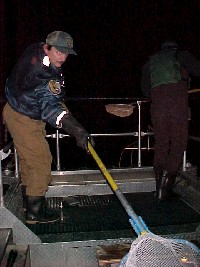 Click on image to enlarge (72K).
Click on image to enlarge (72K).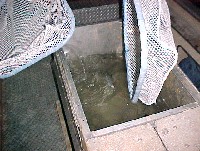 Click on image to enlarge (91K).
Click on image to enlarge (91K). Click on image to enlarge (52K).
Click on image to enlarge (52K).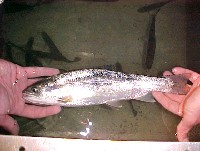 Click on image to enlarge (58K).
Click on image to enlarge (58K).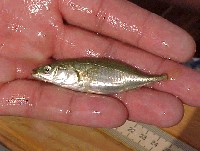 Click on image to enlarge (55K).
Click on image to enlarge (55K).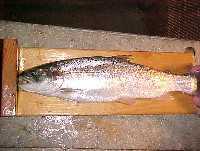 Click on image to enlarge (85K).
Click on image to enlarge (85K).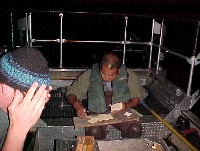 Click on image to enlarge (63K).
Click on image to enlarge (63K).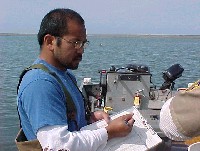 Click on image to enlarge (62K).
Click on image to enlarge (62K).
To learn more about this topic click Info Links
To view additional information (data source, aquisition date etc.) about this page, click Metadata
| www.krisweb.com |
